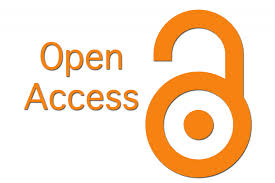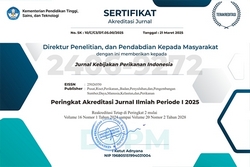KONSERVASI DAN MORFOMETRIK INDUK PENYU YANG MENDARAT PADA PERIODE FEBRUARI - APRIL 2022 DI PULAU KAPOPOSANG DAN TAMBAKHULU, PROVINSI SULAWESI SELATAN
Abstract
Identifikasi dan morfometrik induk penyu ini merupakan kegiatan rutin yang dilakukan oleh Balai Kawasan Konservasi Perairan Nasional untuk mengidentifikasi jenis induk penyu yang mendarat, pengukuran terhadap morfometrik induk penyu, serta mengetahui kondisi lingkungan ditempat mendaratnya induk penyu pada periode Februari sampai dengan Maret 2022. Metode yang dilakukan menggunakan metode observasi, dokumentasi dan wawancara. Hasil Penelitian didapatkan dua jenis induk penyu yaitu jenis penyu hijau dan jenis penyu sisik, sebanyak 10 induk penyu yang berhasil diukur morfomteriknya dengan panjang tubuh rata-rata 110-133 cm, panjang karapas 83-103 cm dan jumlah total telur sebanyak 1.957 butir yang ditemukan juga sebanyak 1.726 yang berhasil menetas jadi tukik selama penelitian. Adapun habitat tempat penyu mendarat memiliki pasir yang bertekstur halus berbatu dengan kemiringan pantai peneluran di pulau Kapoposang dan pulau Tambakhulu termasuk kategori landai dan disukai penyu untuk mendarat dengan kemiringan pantai 15º-18º, suhu pasir rata-rata 28˚C-30ºC, dan kelembaban pasir rata-rata 1 RH-4 RH, dengan vegetasi tumbuhan yaitu beruwas laut (Scaevola taccada), Bay Bean (Canavalia rosea), Cemara (Casuarina equisetifolia), Pohon stigi (Pemphis acidula).
Identification and morphometrics of mother turtles is a routine activity carried out by the National Marine Conservation Area Office to identify the type of mother turtle that landed, measure the morphometrics of the mother turtle, and determine the environmental conditions where the mother turtle landed in the period February to March 2022. The method used using observation, documentation and interview methods. The research results showed that there were two types of turtle parents, namely the green turtle and the hawksbill turtle. A total of 10 turtle parents had their morphological measurements measured with an average body length of 110-133 cm, carapace length of 83-103 cm and a total number of eggs found of 1,957. There were also 1,726 who successfully hatched into hatchlings during the research. The habitat where the turtles land has sand with a fine, rocky texture with a slope of the nesting beaches on Kapoposang Island and Tamba Khulu Island which is in the gentle category and turtles prefer to land with a beach slope of 15º-18º, an average sand temperature of 28˚C-30ºC, and humidity. sand average 1 RH-4 RH, with plant vegetation namely sea bean (Scaevola taccada), Bay Bean (Canavalia rosea), Pine (Casuarina equisetifolia), Stigi tree (Pemphis acidula).
Keywords
Full Text:
PDFReferences
Al-Asif, A., Kamal, A.H.M., Hamli, H., Idris, M.H., Gerusu, G,J., Ismail, J., Bhuiyan, Md.K.A., Abualreesh, M.H., Musa, N., Wahid, M.E.A., & Mishra, M. (2022). Status, Biodiversity, and Ecosystem Services of Seagrass Habitats Within the Coral Triangle in the Western Pacific Ocean. Ocean Sci. J. 57, 147–173. https://doi.org/10.1007/s12601-022-00068-w
Ario, R., Wibowo, E., Pratikto, I & Fajar, S. (2016). Pelestarian habitat penyu dari ancaman kepunahan di turtle and education center (TCEC) bali Jurnal Kelautan Tropis. 19 (1), 60-66. https://doi.org/10.14710/jkt.v19i1.602
Barik, S.K., Mohanty, P.K., Kar, P.K., Behera, B., & Patra, S.K. (2014). Environmental cues for mass nesting of sea turtles. Ocean & Coastal Management, 95, 233-240. https://doi.org/10.1016/j.ocecoaman.2014.04.018 .
Booth, D.T., & Dunstan, A. (2018). A Preliminary Investigation into the Early Embryo Death Syndrome (EEDS) at The World’s Largest Green Turtle Rookery. PloS one, 13(4), e0195462. https://doi.org/10.1371/journal.pone.0195462
Fielder, D.P., Limpus, D.J., Limpus, C.J. (2014). Reproduction and population ecology of the vulnerable western sawshelled turtle, Myuchelys bellii, in the Murray–Darling Basin, Australia. Australian Journal of Zoology, 62(6), 463-476. https://doi.org/10.1071/ZO14070
Gatto, C.R., Matthews, B., Reina, R.D. (2021) Role of incubation environment in determining thermal tolerance of sea turtle hatchlings. Endang Species Res, 44, 397-408. https://doi.org/10.3354/esr01111
Isroni, W., Maulida, N., Muhajir, M.I., Lesmana, P.S., & Ismail, D.A. (2022). Characteristics of turtle laying habitat on vemara beach, Banyuwangi Regency, East Java. IOP Conf. Ser.: Earth Environ. Sci, 1036, 012087. DOI 10.1088/1755-1315/1036/1/012087.
Laloë, J.O., Cozens, J., Renom, B., Taxonera, A., Hays, G.C. (2014). Effects of rising temperature on the viability of an important sea turtle rookery. Nature Clim Change 4, 513–518. https://doi.org/10.1038/nclimate2236
Lu, N., Chen, B., Qing, J., Lei, J., Wang, T., Shi, H., Wang, J. (2022). Transcriptome Analyses Provide Insights into the Auditory Function in Trachemys scripta elegans. Animals, 12(18), 2410. https://doi.org/10.3390/ani12182410.
Moldowan, P.D., Brooks, R.J. & Litzgus, J.D. (2016). Turtles with “teeth”: beak morphology of Testudines with a focus on the tomiodonts of Painted Turtles (Chrysemys spp.). Zoomorphology, 135, 121–135. https://doi.org/10.1007/s00435-015-0288-1
Moss, B. (2017). Marine reptiles, birds and mammals and nutrient transfers among the seas and the land: An appraisal of current knowledge. Journal of Experimental Marine Biology and Ecology, 492, 63-80. https://doi.org/10.1016/j.jembe.2017.01.018.
Pelupessy, Y.A.E.G., Wiradana, P.A., Rosiana, I.W., Widhiantara, I.G. (2021). Status, Trends, and Potentials of Turtles Conservation in Bali: A Mini Review. Jurnal Medik Veteriner, 4(2), 256-268. DOI: 10.20473/jmv.vol4.iss2.2021.256-268
Pike, D.A. (2013). Climate Influences the Global Distribution of Sea Turtle Nesting. Global Ecology and Biogeography, 22(5), 555-566. https://doi.org/10.1111/geb.12025
Rajamani, L., & Marsh, H. (2014). Mapping seagrass cost-effectively in the Coral Triangle: Sabah, Malaysia as a case study. Pacific Conservation Biology, 21(2), 113-121. https://doi.org/10.1071/PC14908
Ruthig, G.R., & Gramera,, A.E. (2019). Aggregations of Olive Ridley Sea Turtle (Lepidochelys olivacea Eschholtz, 1829) Nests is Associated with Increased Human Predation during an Arribada event. Herpetology Notes, 12, 1-7.
Santos, R.G, Martins, A.S, Batista, M.B, Horta, P.A. (2015). Regional and local factors determining green turtle Chelonia mydas foraging relationships with the environment, Mar Ecol Prog Ser, 529, 265-277. https://doi.org/10.3354/meps11276
Siahaan, V.O., Thamrin, T., & Tanjung, A. (2020). Habitat Characteristics Nesting Environment of Green Turtle (Chelonia mydas) Pandan Island of West Sumatera. Journal of Coastal and Ocean Sciences, 1(1), 1-6. https://doi.org/10.31258/jocos.1.1.1-6
Squires, D., Restrepo, V., Garcia, S., Dutton, P. (2018). Fisheries bycatch reduction within the least-cost biodiversity mitigation hierarchy: Conservatory offsets with an application to sea turtles. Marine Policy, 93, 55-61. https://doi.org/10.1016/j.marpol.2018.03.018.
Tanaka, H. (2015). Progression in artificial seedling production of Japanese eel Anguilla japonica . Fish Sci, 81, 11–19. https://doi.org/10.1007/s12562-014-0821-z
Terebiznik, M., Moldowan, P.D., Leivesley, J.A., Massey, M.D., Lacroix, C., Connoy, J.W.H., Rollinson, N. (2020). Hatchling turtles ingest natural and artificial incubation substrates at high frequency. Behav Ecol Sociobiol, 74, 130. https://doi.org/10.1007/s00265-020-02913-1
Toledo, J., Morán-Aceves, B.M, Ibarra, J.E., Liedo, P. (2023). Can Entomopathogenic Nematodes and Their Symbiotic Bacteria Suppress Fruit Fly Pests? A Review. Microorganisms, 11(7), 1682. https://doi.org/10.3390/microorganisms11071682
Tomillo, P.S., Tomás J., Marco, A., Panagopoulou, A., Tavecchia, G. (2022) Environmental changes in the Mediterranean Sea could facilitate the western expansion of loggerhead turtles. Mar Ecol Prog Ser :SHIFTav1. https://doi.org/10.3354/meps14149
Thum, M., Whiting, S.D., Reisser, J., Pendoley, K.L., Pattiaratchi, C.B., Proietti, M., Hetzel, Y., Fisher, R., & Meekan, M.G. (2016). Artificial light on water attracts turtle hatchlings during their near shore transit. The Royal Society Publishing, 3(5), https://doi.org/10.1098/rsos.160142.
Van Dyke, J.U., Spencer, R.–., Thompson, M.B., Chessman, B., Howard, K., Georges, A. (2019). Conservation implications of turtle declines in Australia’s Murray River system. Sci Rep, 9, 1998. https://doi.org/10.1038/s41598-019-39096-3
Witherington, B., Hirama, S., Hardy, R (2012) Young sea turtles of the pelagic Sargassum-dominated drift community: habitat use, population density, and threats. Mar Ecol Prog Ser, 463, 1-22. https://doi.org/10.3354/meps09970
DOI: http://dx.doi.org/10.15578/jkpi.17.1.2025.%25p

Jurnal Kebijakan Perikanan Indonesia is licensed under a Creative Commons Attribution-ShareAlike 4.0 International License.
View My Stats
p-ISSN 1979-6366
e-ISSN 2502-6550














